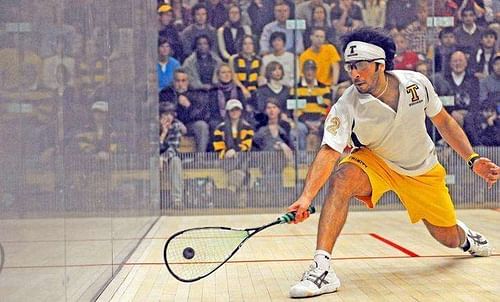
The hidden strength of Indian squash
When he won two PSA tour titles in the space of four months, Vikram Malhotra had many wonder why his name did not figure in the Indian national team. The US-based young man, in fact, is not new to the squash fraternity in the country. As a top junior once, Vikram had represented India in the Asian and World championships a decade ago.
The good performance levels helped him in his pursuit of excellence to the US, to Trinity in fact. He went out of the Indian circuit which was nothing new. As National Coach Cyrus Poncha said, nearly 90 per cent of the young squash players who show promise to make it big generally go out from the scene mostly in pursuit of higher studies.
In the case of Vikram, Poncha said, “We did get in touch with him seeking his convenience to attend trials and stake a claim for a berth in the senior team.” But work (he is currently an assistant coach in Trinity college) has held him back and it has to be seen if more good results from his racket will inspire him to keep knocking on the door of success.
There is no doubt that after his latest win, his second career title in the Malaysian tour event, Vikram will certainly zoom far ahead of his current best of 92 in the world rankings. At the Florida State Open last December, he had risen from being a qualifier to clinch the title. Enroute to the final he had beaten Pakistan's top player Farhan Zaman in the semi-final.
In a way, Vikram represents that class of players who form the hidden strength of Indian squash. And this number can be quite large. Quite a few of them are in the US itself pursuing studies in some of the esteemed institutions there.
A few who have played in University competitions this year include Rishi for Colombia, Madhav for Harvard, Ishaan for F and M, Ness Billimoria for St Lawrence, Abhimanyu for Princeton.
In addition, the ones who attracted special attention were Arjun Kocchar of Yale, Saumya Karki for Harvard and Anaka Alankamony for Pennsylvania. The three were in the teams which played in the final of the national competition.
Arjun was the star performer for Yale in its race for the title over Rochester after a gap of 26 years. On the other hand Saumya, who was the captain, outdid Anaka by helping Harvard beat Pennsylvania in the women's final. The point is, all of them had undertaken their formative years in the sport in India.
Among the recent recruits there, Anaka was looked upon once as India's top junior with credentials to make it big like her predecessors Joshna Chinappa and Dipika Pallikal. Even when she moved to Pennsylvania, she had the resolve to remain in top gear and help the Indian national team. However, it was tough and it did not take long before Anaka faded away.
Whether this Chennai girl can come back to the professional circuit, as is her goal, only time will tell. But as SRFI Coaching Consultant Maj S. Maniam said, “Anaka is a talented squash player with the skill and mindset to match. But it will be a great challenge, and a great achievement if she can come make a positive comeback.”
There are exceptions, however. Siddarth Suchde too left the country in his prime and when he completed his education at Harvard, he was 23. The Mumbai player grittily continued playing professional squash and represented India even from abroad. He was a member of the Indian team which won a medal in the Asian Games 2010 in Guangzhou.
But then as the seasons went by Siddarth developed other interests and passions, and he quit the sport at the age of 28 to pursue those other dreams.
Ultimately then, it is a question of how inspired the player is to make a comeback. Where there is a will there is a way, of course. But there's no doubting that the hidden strength of Indian squash continues to grow.
